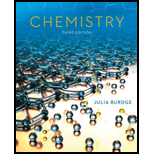
Concept explainers
Lysozyme is an enzyme that cleaves bacterial cell walls. A sample of lysozyme extracted from egg white has a molar mass of 13,930 g. A quantity of 0.100 g of this enzyme is dissolved in 150 g of water at
Interpretation:
The vapor pressure lowering, depression in freezing point, elevation in boiling point, and atmospheric pressure of the solution are to be calculated with given molar mass of enzyme.
Concept Introduction:
The property that depends on the concentration of solute molecules and not on the identity of solute is termed as colligative property.
The four colligative properties of solution are vapor-pressure lowering, boiling point elevation, freezing point depression, and osmotic pressure.
Vapor pressure lowering is directly proportional to the mole fraction of the solute.
The pressure exerted by a solvent is equal to the product of that solvent’s mole fraction and the pressure exerted by the pure solvent. It is expressed as
Here,
Freezing point depression occurs when a nonvolatile solute is added to a solvent.
Freezing point depression is calculated by using the expression given below:
Here,
Elevation in boiling point occurs when a nonvolatile solute is added to a pure solvent.
Boiling point elevation is calculated by using the expression given below:
Here,
Osmotic pressure is the pressure that has to be applied to prevent the pure solvent to pass to a solution by osmosis.
The osmotic pressure is calculated by using the expression given below:
Here,
The number of moles is calculated by dividing the given mass of the compound by the molar mass. It is expressed as
Here,
The mole fraction of compound can be calculated as
Answer to Problem 135AP
Solution:
Explanation of Solution
Given information: Molar mass of the enzyme is
Mass of enzyme is
Mass of water is
Temperature is
Vapor pressure of pure water is
Calculate the number of moles of lysozyme by dividing the given mass of enzyme with the molar mass of the enzyme. It is calculated as
Calculate the number of moles of water by dividing the given mass of water with the molar mass of water. It is calculated as
Calculate the mole fraction of lysozyme as
The lowering in vapor pressure is calculated as follows by using the expression given below:
Substitute the values of mole fraction and vapor pressure of water
Freezing point depression is calculated by using the expression given below:
Here,
Substitute the required values
Boiling point elevation is calculated by using the expression given below:
Here,
Substitute the required values
Calculate the osmotic pressure by using the expression given below:
Here,
Assuming the density of solution is
The vapor pressure lowering, depression in freezing point, elevation in boiling point, and atmospheric pressure of the solution are
Want to see more full solutions like this?
Chapter 13 Solutions
Chemistry-Connect Plus Access
- What would be the freezing point of a solution formed by adding 1.0 mole of glucose (a molecular compound) to the following amounts of water? a. 250 g (0.25 kg) b. 500 g (0.500 kg) c. 1000 g (1.000 kg) d. 2000 g (2.000 kg)arrow_forwardCalculate the freezing point of 525 g of water that contains 25.0 g of NaCl. Assume i, the vant Hoff factor, is 1.85 for NaCl.arrow_forwardWater at 25 C has a density of 0.997 g/cm3. Calculate the molality and molarity of pure water at this temperature.arrow_forward
- Define the terms in Raoults law. Figure 10-9 illustrates the net transfer of water molecules from pure water to an aqueous solution of a nonvolatile solute. Explain why eventually all of the water from the beaker of pure water will transfer to the aqueous solution. If the experiment illustrated in Fig. 10-9 was performed using a volatile solute, what would happen? How do you calculate the total vapor pressure when both the solute and solvent are volatile?arrow_forwardConsider two solutions, A and B, separated by an osmotic semipermeable membrane that allows only water to pass through, as shown in the diagram in Problem 8-113. Based on each of the following identities for solutions A and B, indicate whether the liquid level in compartment A, with time, will increase, decrease, or not change. a. A = 1.0 M glucose solution and B = 2.0 M glucose solution b. A = 5.0%(m/v) NaCl solution and B = 4.0%(m/v) NaCl solution c. A = 2.0 M Na2SO4 solution and B = 3.0 M KNO3 solution d. A = 2.0 M glucose solution and B = 1.0 M NaCl solutionarrow_forwardErythrocytes are red blood cells containing hemoglobin. In a saline solution they shrivel when the salt concentration is high and swell when the salt concentration is low. In a 25C aqueous solution of NaCl, whose freezing point is 0.406C, erythrocytes neither swell nor shrink. If we want to calculate the osmotic pressure of the solution inside the erythrocytes under these conditions, what do we need to assume? Why? Estimate how good (or poor) of an assumption this is. Make this assumption and calculate the osmotic pressure of the solution inside the erythrocytes.arrow_forward
 Chemistry: An Atoms First ApproachChemistryISBN:9781305079243Author:Steven S. Zumdahl, Susan A. ZumdahlPublisher:Cengage Learning
Chemistry: An Atoms First ApproachChemistryISBN:9781305079243Author:Steven S. Zumdahl, Susan A. ZumdahlPublisher:Cengage Learning Chemistry & Chemical ReactivityChemistryISBN:9781337399074Author:John C. Kotz, Paul M. Treichel, John Townsend, David TreichelPublisher:Cengage Learning
Chemistry & Chemical ReactivityChemistryISBN:9781337399074Author:John C. Kotz, Paul M. Treichel, John Townsend, David TreichelPublisher:Cengage Learning Chemistry & Chemical ReactivityChemistryISBN:9781133949640Author:John C. Kotz, Paul M. Treichel, John Townsend, David TreichelPublisher:Cengage Learning
Chemistry & Chemical ReactivityChemistryISBN:9781133949640Author:John C. Kotz, Paul M. Treichel, John Townsend, David TreichelPublisher:Cengage Learning
 ChemistryChemistryISBN:9781305957404Author:Steven S. Zumdahl, Susan A. Zumdahl, Donald J. DeCostePublisher:Cengage Learning
ChemistryChemistryISBN:9781305957404Author:Steven S. Zumdahl, Susan A. Zumdahl, Donald J. DeCostePublisher:Cengage Learning General, Organic, and Biological ChemistryChemistryISBN:9781285853918Author:H. Stephen StokerPublisher:Cengage Learning
General, Organic, and Biological ChemistryChemistryISBN:9781285853918Author:H. Stephen StokerPublisher:Cengage Learning





